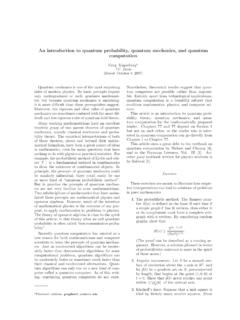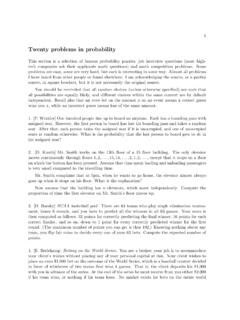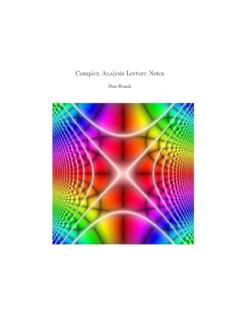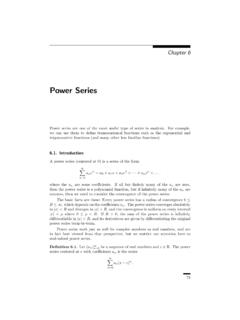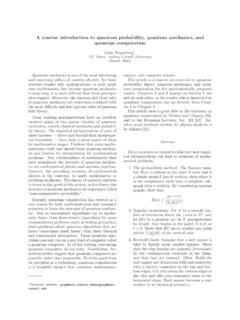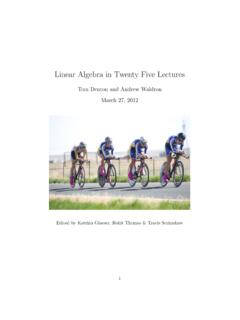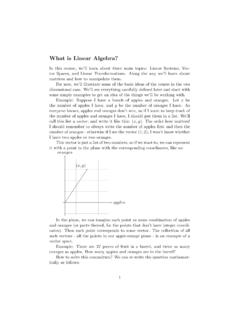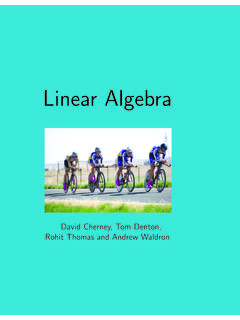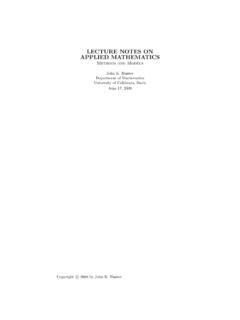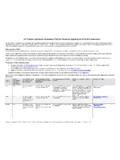Transcription of Series - University of California, Davis
1 Chapter 4 SeriesDivergent Series are the devil, and it is a shame to base on themany demonstration whatsoever. (Niels Henrik Abel, 1826)This Series is divergent, therefore we may be able to do somethingwith it. (Oliver Heaviside, quoted by Kline)In this chapter, we apply our results for sequences to Series , or infinite convergence and sum of an infinite Series is defined in terms of its sequence offinite partial Convergence of seriesA finite sum of real numbers is well-defined by the algebraic properties ofR, but inorder to make sense of an infinite Series , we need to consider its convergence. Wesay that a Series converges if its sequence of partial sums converges, and in thatcase we define the sum of the Series to be the limit of its partial (an) be a sequence of real numbers. The Series n=1anconverges to a sumS Rif the sequence (Sn) of partial sumsSn=n k=1akconverges toSasn . Otherwise, the Series a Series converges toS, we writeS= n= SeriesWe also say a Series diverges to if its sequence of partial sums does.
2 As forsequences, we may start a Series at other values ofnthann= 1 without changingits convergence properties. It is sometimes convenient to omit the limits on a serieswhen they aren t important, and write it as |a|<1, then the geometric Series with ratioaconverges and itssum is n=0an=11 Series is simple enough that we can compute its partial sums explicitly,Sn=n k=0ak=1 an+11 shown in Proposition , if|a|<1, thenan 0 asn , so thatSn 1/(1 a), which proves the geometric Series diverges to ifa 1, and diverges in an oscillatoryfashion ifa 1. The following examples consider the casesa= 1 in Series n=11 = 1 + 1 + 1 +..diverges to , since itsnth partial sum isSn= Series n=1( 1)n+1= 1 1 + 1 1 +..diverges, since its partial sumsSn={1 ifnis odd,0 ifnis even,oscillate between 0 and Series illustrates the dangers of blindly applying algebraic rules for finitesums to Series . For example, one might argue thatS= (1 1) + (1 1) + (1 1) + = 0 + 0 + 0 + = 0,or thatS= 1 + ( 1 + 1) + ( 1 + 1) + = 1 + 0 + 0 + = 1,or that1 S= 1 (1 1 + 1 1 +.)}
3 = 1 1 + 1 1 + 1 =S,so 2S= 1 orS= 1 Italian mathematician and priest Luigi Grandi (1710) suggested that theseresults were evidence in favor of the existence of God, since they showed that itwas possible to create something out of Convergence of series61 Telescoping Series of the form n=1(an an+1)are another class of Series whose partial sumsSn=a1 an+1can be computed explicitly and then used to study their convergence. We give Series n=11n(n+ 1)=11 2+12 3+13 4+14 5+..converges to 1. To show this, we observe that1n(n+ 1)=1n 1n+ 1,son k=11k(k+ 1)=n k=1(1k 1k+ 1)=11 12+12 13+13 14+ +1n 1n+ 1= 1 1n+ 1,and it follows that k=11k(k+ 1)= condition for the convergence of Series with positive terms follows immedi-ately from the condition for the convergence of monotone Series anwith positive termsan 0 converges if and onlyif its partial sumsn k=1ak Mare bounded from above, otherwise it diverges to . partial sumsSn= nk=1akof such a Series form a monotone increasingsequence, and the result follows immediately from Theorem Although we have only defined sums of convergent Series , divergent Series arenot necessarily meaningless.
4 For example, the Ces`aro sumCof a Series anisdefined byC= limn 1nn k=1Sn, Sn=a1+a2+ + SeriesThat is, we average the firstnpartial sums the Series , and letn . One canprove that if a Series converges toS, then its Ces`aro sum exists and is equal toS,but a Series may be Ces`aro summable even if it is the Series ( 1)n+1in Example , we find that1nn k=1Sk={1/2 + 1/(2n) ifnis odd,1/2ifnis even,since theSn s alternate between 0 and 1. It follows the Ces`aro sum of the Series isC= 1/2. This is, in fact, what Grandi believed to be the true sum of the `aro summation is important in the theory of Fourier Series . There are alsomany other ways to sum a divergent Series or assign a meaning to it (for example,as an asymptotic Series ), but we won t discuss them further The Cauchy conditionThe following Cauchy condition for the convergence of Series is an immediate con-sequence of the Cauchy condition for the sequence of partial (Cauchy condition).}
5 The Series n=1anconverges if and only for every >0 there existsN Nsuch that n k=m+1ak =|am+1+am+2+ +an|< for alln > m > Series converges if and only if the sequence (Sn) of partial sums isCauchy, meaning that for every >0 there existsNsuch that|Sn Sm|= n k=m+1ak < for alln > m > N,which proves the result. A special case of this theorem is a necessary condition for the convergence ofa Series , namely that its terms approach zero. This condition is the first thing tocheck when considering whether or not a given Series the Series n=1anconverges, thenlimn an= the Series converges, then it is Cauchy. Takingm=n 1 in the Cauchycondition in Theorem , we find that for every >0 there existsN Nsuch that|an|< for alln > N, which proves thatan 0 asn . The Cauchy condition63 Example geometric Series anconverges if|a|<1 and in that casean 0 asn . If|a| 1, thenan6 0 asn , which implies that the condition that the terms of a Series approach zero is not, however, sufficientto imply convergence.
6 The following Series is a fundamental harmonic Series n=11n= 1 +12+13+14+..diverges, even though 1/n 0 asn . To see this, we collect the terms insuccessive groups of powers of two, n=11n= 1 +12+(13+14)+(15+16+17+18)+(19+110+ +116)+..>1 +12+(14+14)+(18+18+18+18)+(116+116+ +116)+..>1 +12+12+12+12+..In general, for everyn 1, we have2n+1 k=11k= 1 +12+n j=12j+1 k=2j+11k>1 +12+n j=12j+1 k=2j+112j+1>1 +12+n j=112>n2+32,so the Series diverges. We can similarly obtain an upper bound for the partial sums,2n+1 k=11k<1 +12+n j=12j+1 k=2j+112j< n+ inequalities are rather crude, but they show that the Series diverges at alogarithmic rate, since the sum of 2nterms is of the ordern. This rate of divergenceis very slow. It takes 12367 terms for the partial sums of harmonic Series to exceed10, and more than 1043terms for the partial sums to exceed more refined argument, using integration, shows thatlimn [n k=11k logn]= where is the Euler constant.
7 (See Example )644. Absolutely convergent seriesThere is an important distinction between absolutely and conditionally Series n=1anconverges absolutely if n=1|an|converges,and converges conditionally if n=1anconverges, but n=1|an| will show in Proposition below that every absolutely convergent seriesconverges. For Series with positive terms, there is no difference between convergenceand absolute convergence. Also note from Proposition that anconvergesabsolutely if and only if the partial sums nk=1|ak|are bounded from geometric Series anis absolutely convergent if|a|< alternating harmonic Series , n=1( 1)n+1n= 1 12+13 14+..is not absolutely convergent since, as shown in Example , the harmonic seriesdiverges. It follows from Theorem below that the alternating harmonic seriesconverges, so it is a conditionally convergent Series . Its convergence is made possibleby the cancelation between terms of opposite we show next, the convergence of an absolutely convergent Series followsfrom the Cauchy condition.
8 Moreover, the Series of positive and negative termsin an absolutely convergent Series converge separately. First, we introduce someconvenient positive and negative parts of a real numbera Rare givenbya+={aifa >0,0 ifa 0,a ={0ifa 0,|a|ifa < follows, in particular, that0 a+,a |a|, a=a+ a ,|a|=a++a .We may then split a Series of real numbers into its positive and negative the alternating harmonic Series n=1an= 1 12+13 14+15 16+.. Absolutely convergent series65 Its positive and negative parts are given by n=1a+n= 1 + 0 +13+ 0 +15+ 0 +.., n=1a n= 0 +12+ 0 +14+ 0 +16+..Both of these Series diverge to infinity, since the harmonic Series diverges and n=1a+n> n=1a n=12 n= absolutely convergent Series converges. Moreover, n=1anconverges absolutely if and only if the Series n=1a+n, n=1a nof positive and negative terms both converge. Furthermore, in that case n=1an= n=1a+n n=1a n, n=1|an|= n=1a+n+ n=1a anis absolutely convergent, then |an|is convergent, so it satisfiesthe Cauchy condition.}}
9 Since n k=m+1ak n k=m+1|ak|,the Series analso satisfies the Cauchy condition, and therefore it the second part, note that0 n k=m+1|ak|=n k=m+1a+k+n k=m+1a k,0 n k=m+1a+k n k=m+1|ak|,0 n k=m+1a k n k=m+1|ak|,which shows that |an|is Cauchy if and only if both a+n, a nare follows that |an|converges if and only if both a+n, a nconverge. In that664. Seriescase, we have n=1an= limn n k=1ak= limn (n k=1a+k n k=1a k)= limn n k=1a+k limn n k=1a k= n=1a+n n=1a n,and similarly for |an|, which proves the proposition. It is worth noting that this result depends crucially on the completeness thata+n,a n Q+are positive rational numbers such that n=1a+n= 2, n=1a n= 2 2,and letan=a+n a n. Then n=1an= n=1a+n n=1a n= 2 2 2/ Q, n=1|an|= n=1a+n+ n=1a n= 2 , the Series converges absolutely inQ, but it doesn t converge The comparison testOne of the most useful ways of showing that a Series is absolutely convergent is tocompare it with a simpler Series whose convergence is already (Comparison test).
10 Suppose thatbn 0 and n=1bnconverges. If|an| bn, then n=1anconverges bnconverges it satisfies the Cauchy condition, and sincen k=m+1|ak| n k=m+ The comparison test67the Series |an|also satisfies the Cauchy condition. Therefore anconvergesabsolutely. Example Series n=11n2= 1 +122+132+142+..converges by comparison with the telescoping Series in Example We have n=11n2= 1 + n=11(n+ 1)2and0 1(n+ 1)2<1n(n+ 1).We also get the explicit upper bound n=11n2<1 + n=11n(n+ 1)= fact, the sum is n=11n2= (1644) posed the problem of finding this sum, which was solved by Euler(1735). The evaluation of the sum is known as the Basel problem, perhaps afterEuler s birthplace in Series in Example is a special case of the following Series ,called thep- Series , n=11np,where 0< p < . It follows by comparison with the harmonic Series in Exam-ple that thep- Series diverges forp 1. (If it converged for somep 1, thenthe harmonic Series would also converge.)

